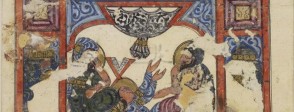This starter activity focuses on the manuscript itself.
Show students the image on the white board. Ask them in pairs to identify the following details:
- 2 doctors
- patient
- bookstand holding book
- 3 curtains tied up
- 2 turrets
Ask students what they think is going on in the picture. Why do they think this? Compare with the image from the Metropolitan Museum of medicine being prepared in For the classroom. Work out what is happening in that picture: medicine is being prepared on the ground floor and distributed into jars on the upper floor. Look at what is similar in the design of these images and draw students’ attention to the architectural setting. What building do they think this might be where such activities to do with healing people took place?
The next activities focus on the action in the picture and Islamic medicine.
The text on the page translates as ‘… vinegar mixed with salt water will help if poured on malignant ulcers, putrid or musty sores, dog bites and the bites of poisonous insects..’ Ask students to imagine they are the patient, to choose one of the ailments mentioned and then invent a story about how they became injured. They should then look at the two pictures from De Materia Medica and describe their trip to the doctor and then to the pharmacist where they received a jar of medicine. Did the honey make the medicine taste better and did they recover?
Look at the photos on the website of Discover Islamic Art in For the classroom including the illustrations in the manuscripts. Look out pictures or the actual modern equivalents of everything the students find. Compare the design, what is written on them, what they are made of. This could lead into a longer enquiry about the differences between modern medicine and the relatively advanced medicine of the Islamic world at this time, including aspects such as vaccination, antiseptics and anaesthetics.
The next two activities could be done separately or combined to create a classroom display of Baghdad.
How was the city of Baghdad laid out?
Read aloud these five descriptions of Baghdad and ask students to sketch the city quickly as you describe it:
- The main city of Baghdad was based inside a large rounded wall.
- Immense streets crossed the city from one end to the other, dividing it into blocks or quarters.
- There were gates at the north-east, north-west, south-east and south-west.
- The river Tigris ran to the east, outside the round city – in a diagonal from north-west to south-east.
- Palaces and gardens lined the riverbank beyond the main city walls.
Now show the students the map of the city in For the classroom and see how they managed. Print off the descriptions of the city in For the classroom, give them to small groups of students and ask them to identify on the map the key features of the city mentioned in the descriptions.
Look again at the British Museum and Metropolitan Museum manuscripts and focus on the buildings in which the activities are taking place. Ask students to use the building outlines in the manuscripts and the descriptions to create a palace, a mosque, a hospital, a set of baths, a gondola or a garden. These could be displayed to create a large view of the city with the river in front.
Use the BBC videos in For the classroom to investigate how Arabic scholars used ideas which had survived from the Greek world.
This activity is inspired by one of Baghdad’s most famous rulers – Harun al-Rashid.
One of the first founders of Baghdad was Harun al-Rashid who often featured in the Arabian Nights – a coin of his is in For the classroom. Sindbad, one of the most famous stories, is set during the reign of Harun. Introduce Sindbad as a merchant and sailor who became rich by sailing across the oceans and trading. Use the Sixth story of Sindbad – when he goes to Sri Lanka – to discuss the riches that Sindbad discovers and also the dangers of seafaring. The gemstones described in the story were regularly traded across the Indian Ocean. At this time, merchants from Arabia and South Asia were regularly crossing this great expanse of sea. Investigate how far these ships travelled. Find out more about dhows and the other kinds of ships these sailors travelled in.
Here are two more general enquiry questions, both starting from the four gates of Baghdad.
How did the location of the city contribute to Baghdad’s importance?
Use the four gates of Baghdad to identify its connections to other places. Use an internet map to zoom out from Baghdad and see its position in context. Each direction, Mecca, the Indian Ocean, the Mediterranean, the Silk Road, can be the starting point for an enquiry.
What was important to the people of Baghdad?
The four gates of Baghdad provide a useful structure for students to think about what was important to the people of Baghdad. Use what these gates led to, the objects from Samarra in A bigger picture and the descriptions of the city in For the classroom to explore this question. Discuss which people benefited from these different aspects.


